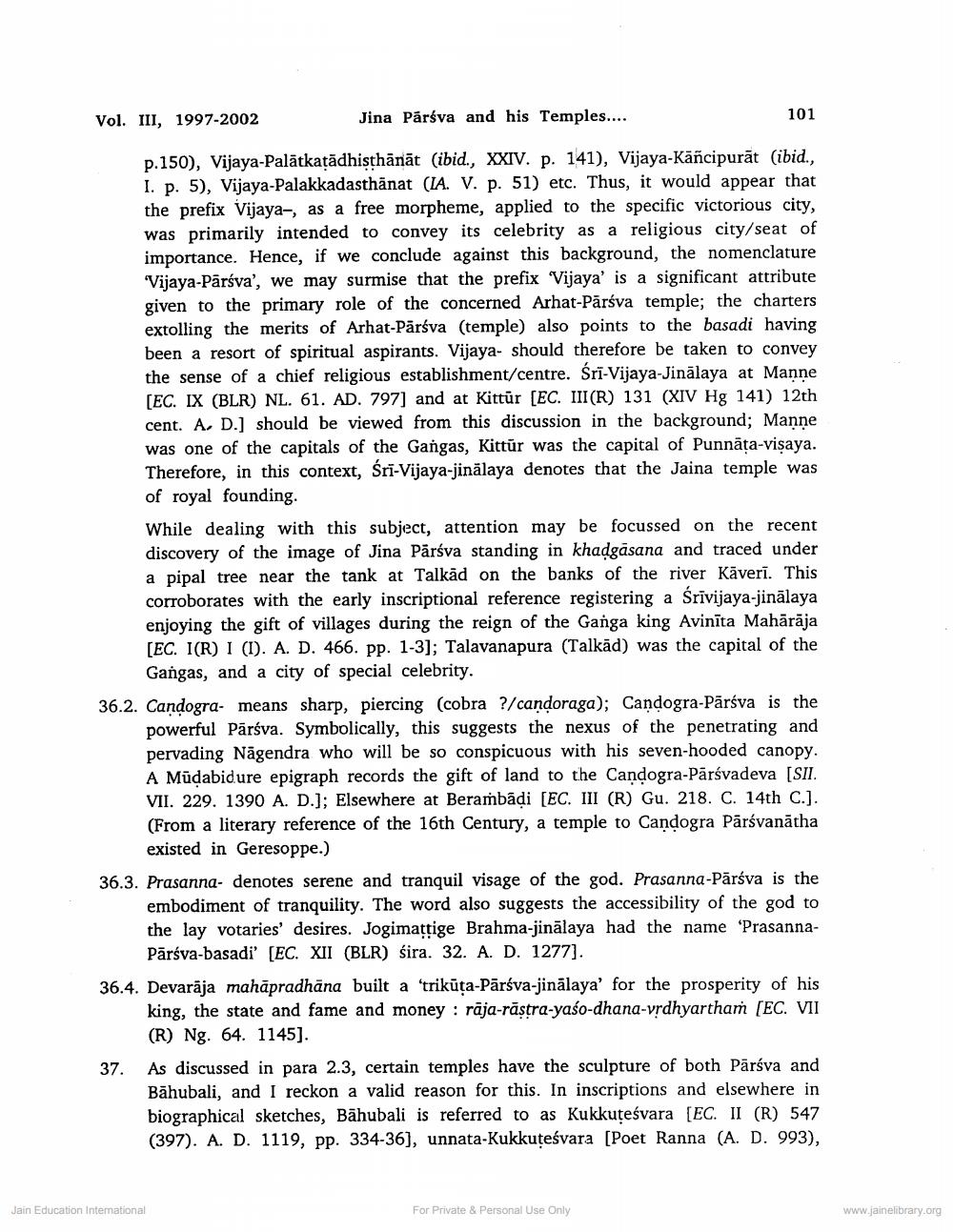________________
Vol. III, 1997-2002
Jina Pārsva and his Temples....
101
p. 150), Vijaya-Palātkatādhisthānāt (ibid., XXIV. p. 141), Vijaya-Kāñcipurāt (ibid., I. p. 5), Vijaya-Palakkadasthānat (IA. V. p. 51) etc. Thus, it would appear that the prefix Vijaya-, as a free morpheme, applied to the specific victorious city, was primarily intended to convey its celebrity as a religious city/seat of importance. Hence, if we conclude against this background, the nomenclature Vijaya-Pārsva', we may surmise that the prefix Vijaya' is a significant attribute given to the primary role of the concerned Arhat-Pārśva temple; the charters extolling the merits of Arhat-Pārśva (temple) also points to the basadi having been a resort of spiritual aspirants. Vijaya- should therefore be taken to convey the sense of a chief religious establishment/centre. Sri-Vijaya-Jinālaya at Manne [EC. IX (BLR) NL. 61. AD. 797] and at Kittur (EC. III(R) 131 (XIV Hg 141) 12th cent. A. D.) should be viewed from this discussion in the background; Manne was one of the capitals of the Gangas, Kittur was the capital of Punnāta-visaya. Therefore, in this context, Śrī-Vijaya-jinālaya denotes that the Jaina temple was of royal founding. While dealing with this subject, attention may be focussed on the recent discovery of the image of Jina Pārsva standing in khadgasana and traced under a pipal tree near the tank at Talkād on the banks of the river Kāverī. This corroborates with the early inscriptional reference registering a Srivijaya-jinālaya enjoying the gift of villages during the reign of the Ganga king Avinīta Mahārāja [EC. I(R) I (I). A. D. 466. pp. 1-3); Talavanapura (Talkād) was the capital of the
Gangas, and a city of special celebrity. 36.2. Candogra- means sharp, piercing (cobra ?/candoraga); Candogra-Pārśva is the
powerful Pārsva. Symbolically, this suggests the nexus of the penetrating and pervading Nagendra who will be so conspicuous with his seven-hooded canopy. A Mūdabidure epigraph records the gift of land to the Candogra-Pārsvadeva (SII. VII. 229. 1390 A. D.); Elsewhere at Berambādi (EC. III (R) Gu. 218. C. 14th C.). (From a literary reference of the 16th Century, a temple to Candogra Pārsvanātha
existed in Geresoppe.) 36.3. Prasanna- denotes serene and tranquil visage of the god. Prasanna-Pārśva is the
embodiment of tranquility. The word also suggests the accessibility of the god to the lay votaries' desires. Jogimattige Brahma-jinālaya had the name 'Prasanna
Pārsva-basadi' (EC. XII (BLR) śira. 32. A. D. 1277). 36.4. Devarāja mahāpradhāna built a 'triküta-Pārsva-jinālaya' for the prosperity of his
king, the state and fame and money : rāja-rästra-yaśo-dhana-vrdhyartham (EC. VII
(R) Ng. 64. 1145]. 37. As discussed in para 2.3, certain temples have the sculpture of both Pārśva and
Bāhubali, and I reckon a valid reason for this. In inscriptions and elsewhere in biographical sketches, Bāhubali is referred to as Kukkuteśvara (EC. II (R) 547 (397). A. D. 1119, pp. 334-36), unnata-Kukkuteśvara [Poet Ranna (A. D. 993),
Jain Education International
For Private & Personal Use Only
www.jainelibrary.org




